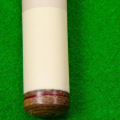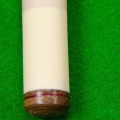Use a lighter stick (18-19 oz). A heavier cue (20-21 oz) results in a slower cue ball; target ball will go to pocket faster. A heavier cue will tend to create more CB speed for a given striking effort. A heavier cue might also be easier for some to keep it in line during the hit, but this is something very individual.
Increased weight can also help prevent stroke deceleration. In addition, a heavier signal could tend to have a shaft with more final mass (although this is not necessarily the case). If that is the case, the heavier cue will create more jet (also known as “cue ball deflection”), which can have advantages and disadvantages for different people. Another potential hazard with a strong signal is that it could result in double hits, thrusts, or errors in large tip offsets depending on the information on the maximum lateral turn resource page.
A heavier signal could also make it more difficult to avoid a double hit when shooting at the CB at a small distance from an OB. The weight of the billiard cue is important for several reasons. The weight of your cue can vary dramatically how well you maintain control of the cue ball, as well as the accuracy of your shots in general.
Pool cues
can weigh from 17 ounces to 21 ounces.Different weights can affect several factors depending on whether it is lighter or heavier. Weight can also affect players' control over Side Spin (or English) and the effectiveness of a player's break. By comparison, changing the leather tip of a normal block with the phenolic tip of a brake pad increases the breaking power of a stroke by 17%. It is perfectly acceptable to change it later; there is also a weight bolt that can be removed from the stud when necessary.
If you already have a cue block with a weight that you feel comfortable with, it may be a good idea to buy a break cue with the same weight. It's not a good idea because the ideal weight of a pool cue depends largely on your own skills. A major obstacle to heavier signals is that there are fewer maximum tip displacement shots from the center, as well as less maximum spin. A lighter pool stick weight will glide better, shaking less out of line due to friction through the guide hand.
Later on, you might find that a different weight pool cue fits better after you've had enough time to try some. The efficiency of the cue and tip can also affect breakage performance; although, some people may not like the feel of the hit with a really hard and efficient tip (e). And even if you're using the optimal weight cue and you're generating the highest possible cue speed, none of that will matter if you're not using a good technique to get a square hit on the lead ball or if you're getting too much involuntary side spin or CB jump. Before buying a taco, it is important to hold it in your hand to get an idea of how it would be handled.
The extra weight at extreme power consumption creates greater counter-friction in the contact of the cleats with the ball, which ultimately turns into backspin power that can reach the length of a table. In addition, some people may have better accuracy when stroking a heavier cue at a slower speed than a lighter cue at a faster speed. Ideally, you should get a cue that weighs 18.5-21 ounces for American pool and one that weighs 17-19 ounces for snooker. As mentioned above, the optimal cue weight for each individual, which provides the best combination of speed and cue weight to produce the best cutting power, is something very personal.
Not only do they make it clear where you should hit the ball with your cue to get the desired results, but they also practice. .



